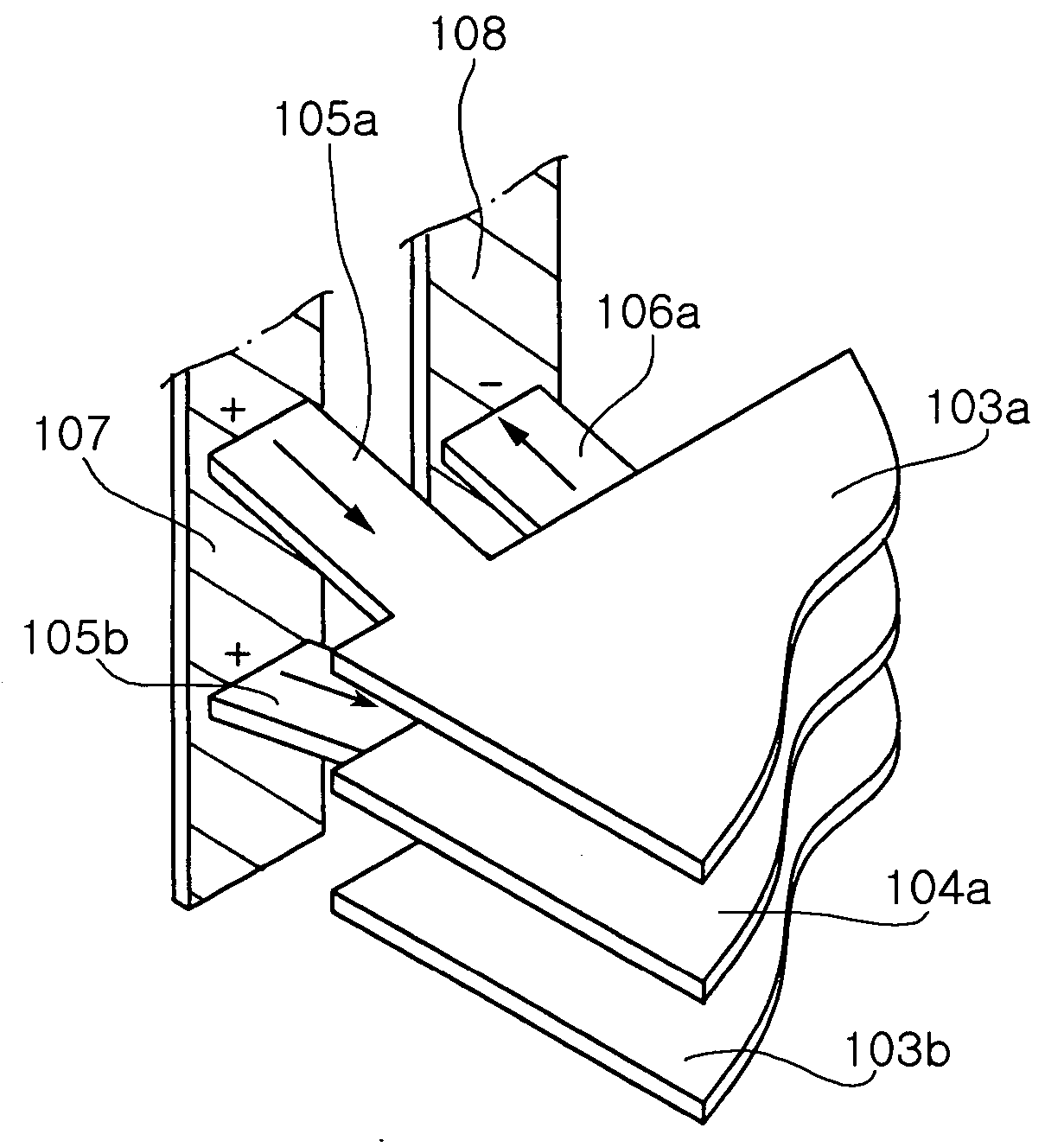Multilayer chip capacitor
a multi-layer chip and capacitor technology, applied in the direction of fixed capacitors, stacked capacitors, fixed capacitor details, etc., can solve the problem of hard to reduce esl sufficiently, and achieve the effect of preventing mutual inductance, reducing esl, and reducing magnetic flux
- Summary
- Abstract
- Description
- Claims
- Application Information
AI Technical Summary
Benefits of technology
Problems solved by technology
Method used
Image
Examples
first embodiment
[0050]FIGS. 7a and 7b are plan views illustrating internal electrodes of the capacitor according to the invention. Referring to FIGS. 7a and 7b, first internal electrodes 203a, 203b include four leads 205a, 205b connected to external electrodes, respectively, and second electrodes 204a, 204b include four leads 206a, 206b connected to external electrodes, respectively. Reference numerals 201a, 201b, 202a and 202b depict dielectric layers. The leads 205a and 205b of the first internal electrodes 203 are adjacent to the leads 206a and 206b of the second internal electrode 204a and 206b with the opposite polarity, thereby canceling magnetic flux generated by respective high-frequency currents. In addition, currents flow in opposite directions in the leads 205a and 205b or the leads 206a and 206b which are adjacent to each other, thereby inhibiting occurrence of strong mutual inductance.
[0051] Respective first internal electrodes 203a and 203b have separated first conductive patterns 203...
second embodiment
[0055]FIGS. 8a and 8b are plan views illustrating the configuration of internal electrodes of a capacitor according to a Referring to FIGS. 8a and 8b, first conductive patterns 303-1a, 303-1b, 304-1a and 304-1b and second conductive patterns 303-2a, 303-2b, 304-2a and 304-2b are shown, in which those formed on the same plane (e.g., the conductive patterns 303-1a and 303-2a) exhibit the opposite polarity. Reference numerals 303a and 303b denote first internal electrodes 303 while reference numerals 304a and 304b denote second internal electrodes 304. As indicated with an arrow in FIGS. 8a and 8b, in this embodiment, currents flow in opposite directions in adjacent areas between the first conductive patterns and second conductive patterns on the same plane, between vertically adjacent leads having the opposite polarity (e.g., 305a and 306a) and inside a conductive pattern, thereby cancelling magnetic flux. Further, currents flow in opposite directions through the vertically adjacent ...
third embodiment
[0057]FIGS. 9a and 9b illustrate the configuration of internal electrodes of a capacitor according to the invention. Referring to FIGS. 9a and 9b, respective first internal electrodes 403 (403a and 403b) and respective second internal electrodes 404 (404a and 404b) have one conductive pattern formed therein. Also, two collinear slits 415 and 425 are formed in the first internal electrodes 403, and another two collinear slits 416 and 426 are formed in the second internal electrodes 404. At this time, the slits 415 and 425 of the conductive patterns of the first internal electrodes 403 are perpendicular to the slits 416 and 426 of the conductive patterns of the second internal electrodes 404. Currents flow in perpendicular directions between the vertically adjacent first internal electrodes 403 and second internal electrodes 404, thereby leading to cancellation of magnetic flux. Moreover, currents flow in opposite directions through vertically adjacent leads having the same polarity s...
PUM
| Property | Measurement | Unit |
|---|---|---|
| angle | aaaaa | aaaaa |
| angle | aaaaa | aaaaa |
| thickness | aaaaa | aaaaa |
Abstract
Description
Claims
Application Information
 Login to View More
Login to View More - R&D
- Intellectual Property
- Life Sciences
- Materials
- Tech Scout
- Unparalleled Data Quality
- Higher Quality Content
- 60% Fewer Hallucinations
Browse by: Latest US Patents, China's latest patents, Technical Efficacy Thesaurus, Application Domain, Technology Topic, Popular Technical Reports.
© 2025 PatSnap. All rights reserved.Legal|Privacy policy|Modern Slavery Act Transparency Statement|Sitemap|About US| Contact US: help@patsnap.com



